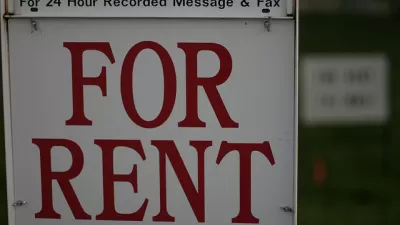Amid the ubiquitous, and inconsistent, reportage on rising rents and housing prices, a guide from City Observatory helps point readers toward the most accurate numbers.
The urgency of housing costs in the United States prompts the need for facts and figures, and the abundance of online real-estate listings would seem to provide. But as the statistics pile up, it's worth remembering that more numbers doesn't mean good numbers.
Daniel Hertz at City Observatory wrote about the need for journalists and would-be-informed citizens to judge the viability of median rental statistics, and followed up with a guide for assessing the reliability of data and its sources.
The guide compares the practices a few mainstay sources of rental data, like HUD and Zillow, and offers general advice for assessing the myriad other sources a reader could encounter.
One takeaway: A simple average of all available listings may be less straightforward than you think.
According to Hertz, averages may be skewed toward the high end of the rental market for a number of reasons: for instance, low-rent apartments or even whole neighborhoods may be underrepresented on many sites, while high-rent units tend to stay listed, and thus present in the data set, for longer.
Another solid tip: Read the fine print. You may not be able to grade the math in every study, but a serious source should certainly be able to offer an explanation as to how it accounts for the kinds of factors Hertz brings up.
FULL STORY: Here’s your definitive field guide to median rent statistics

Alabama: Trump Terminates Settlements for Black Communities Harmed By Raw Sewage
Trump deemed the landmark civil rights agreement “illegal DEI and environmental justice policy.”

Planetizen Federal Action Tracker
A weekly monitor of how Trump’s orders and actions are impacting planners and planning in America.

The 120 Year Old Tiny Home Villages That Sheltered San Francisco’s Earthquake Refugees
More than a century ago, San Francisco mobilized to house thousands of residents displaced by the 1906 earthquake. Could their strategy offer a model for the present?

Ken Jennings Launches Transit Web Series
The Jeopardy champ wants you to ride public transit.

BLM To Rescind Public Lands Rule
The change will downgrade conservation, once again putting federal land at risk for mining and other extractive uses.

Indy Neighborhood Group Builds Temporary Multi-Use Path
Community members, aided in part by funding from the city, repurposed a vehicle lane to create a protected bike and pedestrian path for the summer season.
Urban Design for Planners 1: Software Tools
This six-course series explores essential urban design concepts using open source software and equips planners with the tools they need to participate fully in the urban design process.
Planning for Universal Design
Learn the tools for implementing Universal Design in planning regulations.
Clanton & Associates, Inc.
Jessamine County Fiscal Court
Institute for Housing and Urban Development Studies (IHS)
City of Grandview
Harvard GSD Executive Education
Toledo-Lucas County Plan Commissions
Salt Lake City
NYU Wagner Graduate School of Public Service





























